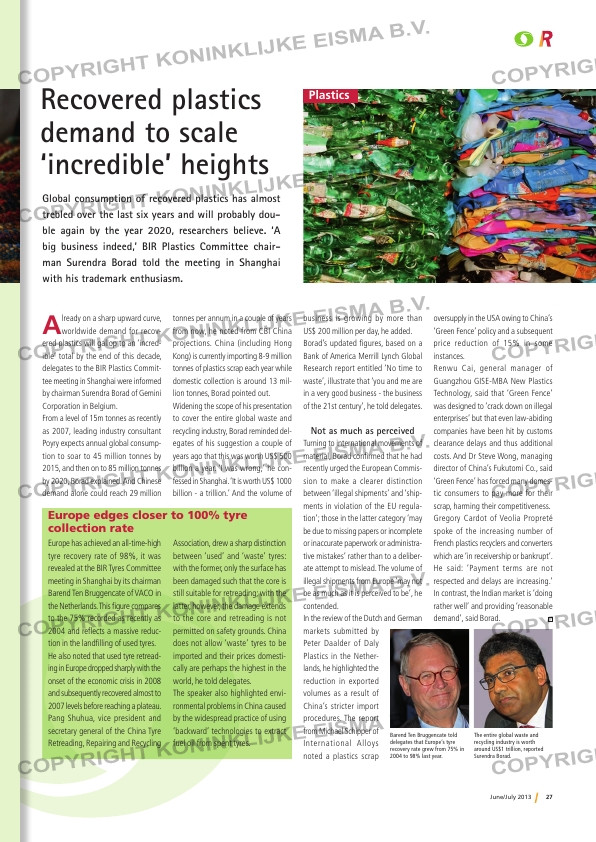Page 27 from: June / July 2013

27June/July 2013
Already on a sharp upward curve, worldwide demand for recov-
ered plastics will gallop to an ‘incred-
ible’ total by the end of this decade,
delegates to the BIR Plastics Commit-
tee meeting in Shanghai were informed
by chairman Surendra Borad of Gemini
Corporation in Belgium.
From a level of 15m tonnes as recently
as 2007, leading industry consultant
Poyry expects annual global consump-
tion to soar to 45 million tonnes by
2015, and then on to 85 million tonnes
by 2020, Borad explained. And Chinese
demand alone could reach 29 million
Europe has achieved an all-time-high
tyre recovery rate of 98%, it was
revealed at the BIR Tyres Committee
meeting in Shanghai by its chairman
Barend Ten Bruggencate of VACO in
the Netherlands. This fi gure compares
to the 75% recorded as recently as
2004 and refl ects a massive reduc-
tion in the landfi lling of used tyres.
He also noted that used tyre retread-
ing in Europe dropped sharply with the
onset of the economic crisis in 2008
and subsequently recovered almost to
2007 levels before reaching a plateau.
Pang Shuhua, vice president and
secretary general of the China Tyre
Retreading, Repairing and Recycling
Association, drew a sharp distinction
between ‘used’ and ‘waste’ tyres:
with the former, only the surface has
been damaged such that the core is
still suitable for retreading; with the
latter, however, the damage extends
to the core and retreading is not
permitted on safety grounds. China
does not allow ‘waste’ tyres to be
imported and their prices domesti-
cally are perhaps the highest in the
world, he told delegates.
The speaker also highlighted envi-
ronmental problems in China caused
by the widespread practice of using
‘backward’ technologies to extract
fuel oil from spent tyres.
Recovered plastics
demand to scale
‘incredible’ heights
Global consumption of recovered plastics has almost
trebled over the last six years and will probably dou-
ble again by the year 2020, researchers believe. ‘A
big business indeed,’ BIR Plastics Committee chair-
man Surendra Borad told the meeting in Shanghai
with his trademark enthusiasm.
oversupply in the USA owing to China’s
‘Green Fence’ policy and a subsequent
price reduction of 15% in some
instances.
Renwu Cai, general manager of
Guangzhou GISE-MBA New Plastics
Technology, said that ‘Green Fence’
was designed to ‘crack down on illegal
enterprises’ but that even law-abiding
companies have been hit by customs
clearance delays and thus additional
costs. And Dr Steve Wong, managing
director of China’s Fukutomi Co., said
‘Green Fence’ has forced many domes-
tic consumers to pay more for their
scrap, harming their competitiveness.
Gregory Cardot of Veolia Propreté
spoke of the increasing number of
French plastics recyclers and converters
which are ‘in receivership or bankrupt’.
He said: ‘Payment terms are not
respected and delays are increasing.’
In contrast, the Indian market is ‘doing
rather well’ and providing ‘reasonable
demand’, said Borad.
Plastics
tonnes per annum in a couple of years
from now, he noted from CBI China
projections. China (including Hong
Kong) is currently importing 8-9 million
tonnes of plastics scrap each year while
domestic collection is around 13 mil-
lion tonnes, Borad pointed out.
Widening the scope of his presentation
to cover the entire global waste and
recycling industry, Borad reminded del-
egates of his suggestion a couple of
years ago that this was worth US$ 500
billion a year. ‘I was wrong,’ he con-
fessed in Shanghai. ‘It is worth US$ 1000
billion – a trillion.’ And the volume of
business is growing by more than
US$ 200 million per day, he added.
Borad’s updated fi gures, based on a
Bank of America Merrill Lynch Global
Research report entitled ‘No time to
waste’, illustrate that ‘you and me are
in a very good business – the business
of the 21st century’, he told delegates.
Not as much as perceived
Turning to international movements of
material, Borad confi rmed that he had
recently urged the European Commis-
sion to make a clearer distinction
between ‘illegal shipments’ and ‘ship-
ments in violation of the EU regula-
tion’; those in the latter category ‘may
be due to missing papers or incomplete
or inaccurate paperwork or administra-
tive mistakes’ rather than to a deliber-
ate attempt to mislead. The volume of
illegal shipments from Europe ‘may not
be as much as it is perceived to be’, he
contended.
In the review of the Dutch and German
markets submitted by
Peter Daalder of Daly
Plastics in the Nether-
lands, he highlighted the
reduction in exported
volumes as a result of
China’s stricter import
procedures. The report
from Michael Schipper of
International Alloys
noted a plastics scrap
Barend Ten Bruggencate told
delegates that Europe’s tyre
recovery rate grew from 75% in
2004 to 98% last year.
The entire global waste and
recycling industry is worth
around US$1 trillion, reported
Surendra Borad.
Europe edges closer to 100% tyre
collection rate
RI-5_BIR Textiles.indd 27 17-06-13 15:27



